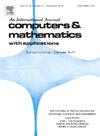多尺度动力学 SIR 流行病模型的渐近保留统一气体动力学方案
IF 2.9
2区 数学
Q1 MATHEMATICS, APPLIED
引用次数: 0
摘要
二维空间多尺度动力学 SIR 流行病模型被广泛用于模拟传染病在人群中的传播。该方案结合了速度变量的离散序数法和空间与时间变量的有限体积法。统一气体动力学方案(UGKS)的思想用于构建需要模型形式积分解的数值边界通量。由于 SIR 模型中三个传输方程的耦合,很难获得这些积分解。我们通过单独构建通量的方式将系统解耦。然后,根据 UGKS 框架,我们可以得到方案中所需的宏观辅助量。这样,SIR 模型就可以按顺序求解了。此外,我们还可以用数值方法证明,该方案在空间和时间上都具有二阶精度。此外,它不仅可以捕捉到扩散极限方程的解,而无需考虑单元大小和时间步长与缩放参数的小相关性,还能以一种自然的方式解决双曲机制中的解。此外,还详细分析了 UGKS 的正特性,并通过添加时间步长约束条件和应用节点限制器,得到了正 UGKS,即 PPUGKS2 阶。此外,为了解除扩散机制中的时间步长约束,还提出了一种时间一阶精度的正保留 UGKS,称为 PPUGKS1-order。最后,我们还进行了一些数值测试,以验证所提方案的性能。本文章由计算机程序翻译,如有差异,请以英文原文为准。
The asymptotic preserving unified gas kinetic scheme for the multi-scale kinetic SIR epidemic model
In this paper, we present an asymptotic preserving scheme for the two-dimensional space-dependent and multi-scale kinetic SIR epidemic model which is widely used to model the spread of infectious diseases in populations. The scheme combines a discrete ordinate method for the velocity variables and finite volume method for the spatial and time variables. The idea of unified gas kinetic scheme (UGKS) is used to construct the numerical boundary fluxes which needs the formal integral solutions of the model. Due to the coupling of the three transfer equations in the SIR model, it is difficult to obtain these integral solutions dependently. We decouple the system by constructing the fluxes in a separate way. Then following the framework of UGKS we can obtain the macro auxiliary quantities which is needed in the scheme. Thus the SIR model can be solved in the sequential way. In addition, we can show numerically that the scheme is second-order accurate both in space and time. Moreover, it can not only capture the solution of the diffusion limit equations without requiring the cell size and time step being related to the smallness of the scaling parameters, but also resolve the solution in hyperbolic regime in a natural way. Furthermore, the positive property of the UGKS is analyzed in detail, and through adding time step constraint conditions and applying nodal limiters together, the positive UGKS, called , is obtained. Moreover, in order release the time step constraints in the diffusion regime, a temporal first-order accuracy positive preserving UGKS, called , is proposed. Finally, several numerical tests are included to validate the performance of the proposed schemes.
求助全文
通过发布文献求助,成功后即可免费获取论文全文。
去求助
来源期刊

Computers & Mathematics with Applications
工程技术-计算机:跨学科应用
CiteScore
5.10
自引率
10.30%
发文量
396
审稿时长
9.9 weeks
期刊介绍:
Computers & Mathematics with Applications provides a medium of exchange for those engaged in fields contributing to building successful simulations for science and engineering using Partial Differential Equations (PDEs).
 求助内容:
求助内容: 应助结果提醒方式:
应助结果提醒方式:


